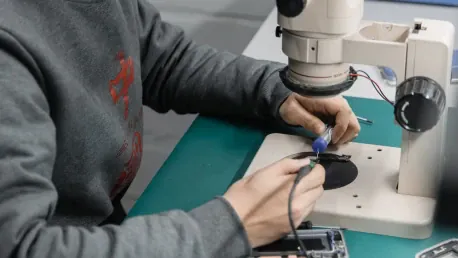Listen to the Article
Mobile devices have come a long way since its inception. While many people predicted its progress would mirror sentiments from science fiction, the path hasn’t been far off. Today, technology has advanced to empower developers to access the previously unattainable and has paved the way for innovations like quantum mechanics to thrive. By integrating the principles of quantum physics with mobile technology, the entire industry has the potential to revolutionize performances and capabilities on a grand scale.
When mobile device manufacturers opt for quantum technology over classical computing, the power of modern smartphones skyrockets—from data processing practices to application security. The mobile device industry is nowhere near halting, and here’s how quantum computing is pushing it forward.
Comparing Computational Characteristics: Classical or Quantum
While most entities are evolving organically, catalyzed by natural elements, computation is also pivoting to perform in unprecedented ways. As the name suggests, classical computing is a traditional approach to binary processing that uses bits to represent data existing in states of either 0 or 1—the backbone of modern smartphone computing. By increasing its power linearly based on the number of transistors and bits, classical computers provide parallel processing and algorithms with good speed.
However, this pales in comparison to the exponential acceleration of quantum computing. By using quantum bits (qubits) that exist in more than one state with an atomic, ionic, or photonic central processing unit (CPU), this next-gen approach to computation unlocks a plethora of power—at a fraction of the energy required for its predecessor. In doing so, qubits can simultaneously perform deeply complex calculations in a way that would otherwise require millions of years of work.
Why It Matters for Mobile Devices
Today’s smartphones are no longer mere mobile devices, but a mini quantum universe. Smartphone processing leverages quantum mechanics to empower transistors to exist at the nanoscale. Similarly, electrons dance to the music of quantum physics every time someone swipes a screen. Even the colors that complement these interactions are created through quantum dots—or microscopic semiconductor particles that emit light to illuminate vibrant displays. However, as technology currently stands, smartphones are not quantum computers. Their processed data is still handled through classical transistors—but the winds of change are blowing the mobile industry toward new horizons.
With a research grant worth $39 million from Cyberagentur, Quantum Brilliance, ParityQC, Oxford Ionics, and NeQxt are blazing the trail for innovation through their efforts to pioneer the world’s first mobile quantum computer by 2027. From civilian to security, the potential to advance industries is vast. For example, national defense applications will enable accelerated real-time biological threat detection without requiring cloud-accessed data centers—whether in combat scenarios or remote locations.
Catapulting Quantum Computing Capabilities in Mobile Technology
Quantum computing has advanced to the point where qubits can be created using synthetic diamonds—the key ingredient in downsizing scale for mobile applications. This begs the question: How will quantum computing transform the mobile technology landscape?
Propelling Processing Power
The laws of quantum mechanics unlock extraordinary computational power compared to the classical computers used in traditional mobile devices. Installing quantum processors in these technologies enables them to drive unprecedented data processing efficiency and tackle complex tasks at an accelerated pace—in turn, boosting user experiences.
Advancing AI and Machine Learning
As a beacon of futuristic innovation, quantum computing has the power to redefine everything it applies to—and artificial intelligence is no exception. Mobile devices with quantum processors can incorporate highly efficient and advanced AI algorithms that support more sophisticated mobile applications.
In the same light, quantum computing can catapult the capabilities of machine learning models with these same algorithms. By propelling the processing and analysis of deep datasets, these models can lead to revolutionary changes in human language understanding, pattern and image recognition, as well as trend predictions.
Securing Mobile App Development
When used with classical computers, the quantum technology used in mobile app development systems continuously identifies any irregularities. However, hackers are drawn to these distorted patterns like flies to honey. By taking a deep recognition approach to quantum computing, app developers can more easily identify these loopholes with a perspective lost to legacy systems. This makes it more complicated for cybercriminals to compromise mobile app data.
Reinventing Mobile Security with Quantum Mechanics
Today’s critical infrastructure, like 5G, leverages classical cryptography with zero trust principles for confidentiality, integrity protection, and authentication. Modern solutions are based on deeply understood primitives, secure practices, and next-gen implementations that protect against different side-channel attacks. These critical infrastructures also rely on traditional encryption methods, like RSA (Rivest-Shamir-Adleman) and AES (Advanced Encryption Standard)—the foundation of modern digital security.
Both RSA and AES involve complicated and computationally intensive mathematical calculations. However, as quantum computing continues to cause waves, the cracks in these encryption methods are beginning to creep up. Quantum computing uses algorithms that tackle calculations that are infeasible for classical computers. This has led to a rise in Harvest Now, Decrypt Later attacks—where threat actors steal data that can’t be immediately decrypted, and save it until a cryptographically relevant quantum computer can.
Quantum Encryption
In response, quantum cryptology emerges as a way to encrypt and share data without the risk of being hacked. Also known as quantum key distribution, the sender pushes data-transmitting photons through a filter—randomly assigning one of four polarizations and bit designations. The receiver then uses two beam splitters to analyze each polarization through a series of guesses. The sender compares these estimations with the initial sequence of polarizers used for the key. Once the incorrect photons are discarded, the remaining bit sequence serves as the new encryption key.
For example, imagine Person A and B want to send a message to each other that no one else can interpret. By leveraging quantum key distribution, Person A sends Person B a series of polarized photons existing in a randomized quantum state through a fiber optic cable. If someone tries intercepting their communication, each photon must be read to reveal the message. However, this adjusts the photon’s quantum state—instigating key errors and immediately alerting Person A and B. This gives them the advantage of discarding the compromised key before any information is leaked.
Conclusion
Implementing quantum computing in mobile devices holds profound promise in today’s technological landscape. From AI and machine learning models to mobile security, quantum processors can simplify complex calculations years before classical computers can crack the code. Additionally, quantum encryption offers the opportunity to eliminate the risk of mobile data infiltration—a critical consideration in today’s increasingly digital world.
Companies that steer toward the future of mobile technology are heading toward never-before-experienced levels of intelligence, accuracy, and security for their devices. The industry may be on the cusp of a revolutionary shift, but the foundation is solid. All that’s left now is to take the quantum leap of faith.









